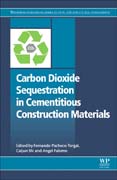
Carbon Dioxide Sequestration in Cementitious Construction Materials
Pacheco-Torgal, Fernando
Shi, Caijun
Sanchez, Angel Paloma
The cement industry represents an important share of greenhouse gas emissions worldwide and the consumption of cement and concrete is going to increase over the coming years due to both economic development and global population growth. WWF estimates that unless cement plants become more efficient or transition to renewable energy sources, the industry - now responsible for some 6 percent of human-caused greenhouse gas emissions - is likely to become a larger contributor to climate change than the European Union by 2030. It is therefore very important that the construction industry develops new products and technologies to mitigate its CO2 emissions and reduce its CO2 footprint. Major research has developed over recent years that could define the future of the cement industry, scientists have found a way during cement production to absorb more carbon dioxide than it emits, acting as a vehicle for carbon capture and sequestration, or CCS. This book provides an updated state-of-the- art review on the development of cementitious construction materials based on carbon dioxide storage, which will have a major eco-efficient and economic benefit for the construction industry. Key chapters include: methods for the assessment of carbon dioxide absorbed by cementitious materials, air and water-based carbon dioxide storage, carbon dioxide storage modelling, carbonation mechanisms , carbon dioxide storage on recycled aggregates, Calcium, sodium and magnesium- based binders, properties and durability of carbon dioxide based concrete. Promotes the importance of CO2 storage in carbonation of these materials especially reincorporation of CO2 during fabricationDiscusses a wide range of cementitious materials with CO2 storage capabilitiesFeatures redesign of cementation mechanisms to utilize CO2 during fabrication INDICE: 1. Introduction to carbon dioxide sequestration based cementitious construction materials Part I. Sequestration methods 2. Carbon dioxide sequestration using aqueous ammonia based 3. Aqueous based carbon dioxide sequestration 4. Carbon dioxide sequestration on vaterite 5. Accelerated carbon dioxide sequestration 6. Modelling carbon dioxide sequestration of steel slag 7. Methods for the assessment of carbon dioxide absorbed by cementitious materials Part II. Carbonation mechanisms 8. Carbon dioxide sequestration on recycled aggregates 9. Carbon dioxide sequestration on alkali activated based binders 10. Carbon dioxide sequestration on magnesium based binders 11. Carbon dioxide sequestration on OPC-FA-MgO based binders 12. Carbon dioxide sequestration on kaolin-cement composites 13. Carbon dioxide sequestration on phosphogypsum and aluminium-rich industrial wastes 14. Carbon dioxide sequestration on biocement composites Part III. Performance and cases studies 15. Carbon dioxide sequestration on alkali-activated based mortars with recycled aggregates. Mechanical performance, carbon footprint and cost analysis 16. Carbon dioxide sequestration on alkali-activated based mortars with recycled aggregates. Properties 17. Carbon dioxide sequestration on alkali-activated based mortars with recycled aggregates reinforced by hemp fibres. Properties 18. Carbon dioxide sequestration on alkali-activated based mortars with recycled aggregates reinforced by hemp fibres. Durability 19. Carbon dioxide sequestration on masonry blocks based on industrial wastes
- ISBN: 978-0-08-102444-7
- Editorial: Woodhead Publishing
- Encuadernacion: Rústica
- Páginas: 510
- Fecha Publicación: 01/10/2018
- Nº Volúmenes: 1
- Idioma: Inglés
